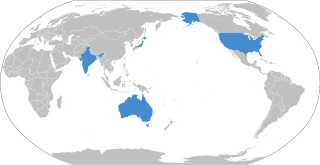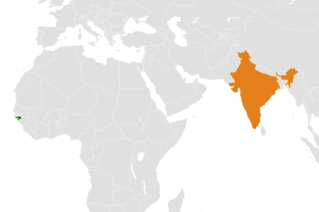
The bilateral relations between the neighboring People's Republic of Bangladesh and the Republic of India, formally began in 1971 with India's recognition of an independent Bangladesh following India's military intervention helping Bangladesh secure independence following the Bangladesh Liberation War.
Pravasi Bharatiya Divas is a celebratory day observed on 9 January by the Republic of India to mark the contribution of the Overseas Indian community towards the development of India. The day commemorates the return of Mahatma Gandhi from South Africa to Mumbai on 9 January 1915.

Sushma Swaraj was an Indian lawyer, politician and diplomat who served as the Former Chief Minister of Delhi, and also the Minister of External Affairs of India in the first Narendra Modi government from 2014 to 2019. She was the second person to complete a 5-year term as the Minister of External Affairs, after Jawaharlal Nehru. A senior leader of the Bharatiya Janata Party (BJP), Swaraj was the second woman to hold the office of Minister of External Affairs, after Indira Gandhi. She was elected seven times as a Member of Parliament and three times as a Member of the Legislative Assembly. At the age of 25 in 1977, she became the youngest cabinet minister of the Indian state of Haryana. She also served as Chief Minister of Delhi for a short duration in 1998 and became the first female Chief Minister of Delhi.
The Ministry of Development of North Eastern Region is a Government of India ministry, established in September 2001, which functions as the nodal Department of the Central Government to deal with matters related to the socio-economic development of the eight States of Northeast India: Arunachal Pradesh, Assam, Manipur, Meghalaya, Mizoram, Nagaland, Tripura and Sikkim. It acts as a facilitator between the Central Ministries/ Departments and the State Governments of the North Eastern Region in the economic development including removal of infrastructural bottlenecks, provision of basic minimum services, creating an environment for private investment and to remove impediments to lasting peace and security in the North Eastern Region.

The bilateral relations between the Himalayan Kingdom of Bhutan and the Republic of India have been traditionally close and both countries share a "special relationship", making Bhutan a protected state, but not a protectorate, of India. India remains influential over Bhutan's foreign policy, defence and commerce. Bhutan is the largest beneficiary of India's foreign aid.

The Act East policy is an effort by the Government of India to cultivate extensive economic and strategic relations with the nations of Southeast Asia to bolster its standing as a regional power and a counterweight to the strategic influence of the People's Republic of China.

India–Vietnam relations, also known as Indian-Vietnamese relations, are the bilateral relations of India and Vietnam.
Ruchira Kamboj is a retired Indian Foreign Service officer of the 1987 batch, who last served as India's Permanent Representative to the United Nations from August 2022 to May 2024 until her retirement. She has previously served as High Commissioner of India to South Africa, first female Indian Ambassador to Bhutan and Ambassador/Permanent Representative of India to UNESCO, Paris.

The Quad is a grouping of Australia, India, Japan, and the United States that is maintained by talks between member countries. The grouping follows the "Tsunami Core Group" and its "new type of diplomacy" developed in response to the 2004 Indian Ocean earthquake and tsunami. It was initiated in 2007 by Japanese Prime Minister Shinzo Abe, with the support of Australian Prime Minister John Howard, Indian Prime Minister Manmohan Singh and U.S. Vice President Dick Cheney. The dialogue was paralleled by joint military exercises of an unprecedented scale, titled Exercise Malabar. The diplomatic and military arrangement was widely viewed as a response to increased Chinese economic and military power.

Subrahmanyam Jaishankar, better known as S. Jaishankar, is an Indian diplomat, politician and author, who is serving as the 30th Minister of External Affairs of the Government of India since 31 May 2019. He is the longest serving Minister of External Affairs since Jawaharlal Nehru, who held the position during his entire 17 years as Prime Minister. Jaishankar is a member of the Bharatiya Janata Party (BJP) and a Member of Parliament (MP) in the Rajya Sabha. He previously served as the Foreign Secretary of India from 2015 to 2018.

The foreign policy of the Modi government, also referred to as the Modi doctrine is associated with the policy initiatives made towards other states by the current government of India after Narendra Modi assumed the office of prime minister on May 26, 2014.

The most significant initiative made by the Narendra Modi government is the focus on neighbouring countries and major Asian powers coupled with emphasizing on the two decades old Look East policy. Asia being the major focus area of his foreign policy, Modi and his foreign minister chose several Asian countries for their initial bilateral visits. He has made state visits to Bhutan and Nepal and Japan within the first 100 days of his government and also hosted Asian leaders like former Prime Minister Tony Abbott of Australia, President Xi Jinping of China and Prime Minister Nguyễn Tấn Dũng of Vietnam, apart from inviting SAARC leaders in his inauguration ceremony. External Affairs Minister Sushma Swaraj has also made official visits to several Asian capitals like Dhaka, Bangladesh, Kathmandu, Nepal, Naypidaw, Myanmar, Singapore, Hanoi, Vietnam, Manama, Bahrain, Kabul, Afghanistan, Dushanbe, Tajikistan, Malé, Maldives, Abu Dhabi, United Arab Emirates, Seoul, South Korea and Beijing China.

Narendra Modi, who is serving the Prime minister of India since 2014. The following is a timeline of the premiership from his inauguration as Prime Minister of India on 26 May 2014 till now.
The Middle East region plays a vital role in India's economy as it supplies nearly two-thirds of India's total oil import, bilateral trade is also flourishing in recent years particularly with UAE and other Arab states of the Persian Gulf. Over the years, millions of Indians mostly working class have migrated to the Persian Gulf region looking for jobs and they account for a sizeable share in the total remittances received from abroad. Indian External Affairs Ministry refers the region as West Asia and not as Middle East which is a more popular attribution, particularly in the Western countries.

The Neighbourhood First policy of India is a core component of India's foreign policy. It focuses on peaceful relations and collaborative, synergetic co-development with its South Asian neighbours of the Indian subcontinent encompassing a diverse range of topics, such as economics, technology, research, education, connectivity, the space program, defence security, and addressing environment and climate challenge. This policy creates new avenues while leveraging to the existing regional cooperation initiatives such as SAARC, SASEC, BBIN, and BIMSTEC. It complements India's Look East policy focused on Southeast Asia and Look West Policy focused on Middle East.

India–Myanmar–Thailand Trilateral Highway, 1,360 km (850 mi) long route, is a 4-lane highway under construction under India's Look East policy that will connect Moreh, India with Mae Sot, Thailand via Myanmar. Imphal-Mandalay-Bangkok 1,813 km (1,127 mi) route, consisting of Imphal-Mandalay 584 km (363 mi) and Mandalay-Bangkok 1,397 km (868 mi), is a highway in good condition except for 101 km (63 mi) part of 120 km (75 mi) long Kalewa-Yagyi stretch being built to 2-lane in each direction highway by India.

Guinea-Bissau–India relations refers to the international relations that exist between Guinea-Bissau and India. The embassy of India in Dakar, Senegal is concurrently accredited to Guinea-Bissau. India opened an Honorary Consulate in Bissau on 28 May 2010. Guinea-Bissau has no diplomatic mission in India.

The 2+2 Ministerial Dialogue is a diplomatic summit that has been held every year since 2018 initially between the Minister of External Affairs or Foreign Minister, and Defence Minister of India with the Secretary of State and Secretary of Defense of the United States to discuss and work on common issues of concern to improve and strengthen India–United States relations.














